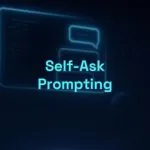Step-Back Prompting: Zoom Out Before You Answer

In complex situations, one of the biggest risks—for both AI and ourselves—is jumping to local solutions without considering the bigger picture. The Step-Back Prompting technique teaches the AI to take a step back and reflect on the problem from a broader perspective before answering.
If you’re an end user who uses AI for problem-solving, critical analysis, or more consistent decision-making, learning to apply Step-Back Prompting will be a game-changer.
This article was created to help end users understand the core concepts, make technical concepts more accessible, and intentionally and explicitly adapt and apply the Step-Back Prompting technique in their daily use of AI, without automatically relying on the model’s capabilities. For further technical exploration, see Learn More.
Table of Contents
What Is the Step-Back Prompting Technique?
Step-Back Prompting is a prompt engineering technique that asks the AI to approach a question or task from a broader or more abstract perspective before focusing on the specifics. Instead of answering directly, the AI first reformulates the question in general terms, analyzes the key principles or concepts involved, and then applies that understanding to the original task. For example, to answer “How can I optimize an email marketing campaign?”, the AI might first explore “What are the general principles of digital marketing?” before detailing specific strategies.
The benefits include greater clarity, more strategic solutions, and the ability to approach complex problems with a holistic mindset. It’s a powerful technique that empowers users at all levels to generate well-grounded answers—especially in analytical or technical contexts.
Origin of Step-Back Prompting
Step-Back Prompting gained attention in 2023 through studies that explored how language models can improve reasoning by reformulating problems in broader terms. Inspired by techniques like Chain-of-Thought and Tree-of-Thought, it is widely used in tools like ChatGPT, Claude, and Gemini, offering a structured approach to complex reasoning.
How Does It Work?
Step-Back Prompting is applied by asking the AI to reformulate the problem from a higher-level perspective, then use that lens to answer the specific question. Follow these steps:
- Define the task or question: Specify the problem that requires analysis (e.g., “How to optimize an email marketing campaign?”).
- Ask for a broader perspective: Instruct the AI to reframe the question in more general terms or identify key principles (e.g., “What are the core principles of digital marketing?”).
- Request the general analysis: Ask the AI to explain the broader concepts clearly.
- Ask for the specific answer: Then instruct the AI to apply the broader view to the original question.
- Specify the format: Choose a clear format such as paragraphs, bullet points, or sections to organize the answer.
Think of it as asking the AI to “zoom out” before zooming in—analyzing the bigger context before diving into the details. You can also iterate, refining the broader perspective or requesting more detail to fine-tune the result.
When to Use It?
Step-Back Prompting is ideal for situations requiring strategic vision, clarity in complex problems, or technical analysis. Use it when you want to:
- Solve complex problems: Perfect for tasks that benefit from a holistic approach, such as planning or optimization.
- Gain clarity: Great for understanding technical or abstract issues from fundamental principles.
- Develop strategies: Ideal for strategic answers in business, technology, or research.
Practical Examples of Step-Back Prompting in Action
See how to apply Step-Back Prompting in real-world scenarios with adaptable prompts. These examples are simple, practical, and reflect common prompt engineering practices, showing how a broader view leads to robust solutions. The first example is interactive, with follow-up prompts refining the general perspective, while the others are direct and straightforward.
Example 1: Optimizing an Email Marketing Campaign (Interactive)
Context: You’re a marketing professional looking to improve the performance of an email campaign.
Initial prompt:
To optimize an email marketing campaign, reframe the question in broader terms and identify three fundamental principles of digital marketing. Explain each principle in one short sentence, using clear language for marketing professionals.Expected response:
Reframed question: What are the general principles of digital marketing that can improve communication campaigns?
Fundamental principles:
- Audience segmentation: Dividing your audience into specific groups allows for more relevant and personalized messages.
- Customer engagement: Creating engaging and interactive content boosts connection and response rates.
- Data analysis: Tracking metrics like open and click rates helps adjust strategies for better performance.
Refinement prompt:
Based on the provided principles, add an additional one about the use of A/B testing in digital marketing. Explain it in one short sentence, using clear language.Expected refinement:
- A/B testing: Testing variations of content, such as subject lines, optimizes performance by identifying what works best.
Final prompt:
Using the four identified principles, explain how to optimize an email marketing campaign. Format the response in bullet points using practical language for a marketing plan.Expected final response:
- Audience segmentation: Split your email list into segments based on interests or behavior, sending personalized content like exclusive deals for frequent customers.
- Customer engagement: Craft compelling subject lines and include clear calls to action, such as “Buy Now” buttons, to drive clicks and conversions.
- Data analysis: Monitor open and conversion rates, adjusting send times or content based on performance metrics.
- A/B testing: Test different subject lines or email layouts, compare results, and apply the most effective version across the campaign.
Why it works:
The interactive example shows a three-step dialogue: the initial prompt reframes the question and identifies principles, the refinement adds one more, and the final prompt applies them in a structured, actionable format. The structure and language ensure practical, effective output.
Example 2: Understanding How Lithium-Ion Battery Technology Works
Context: You’re an engineer researching lithium-ion battery technology for a renewable energy project.
Single prompt:
To explain how lithium-ion battery technology works, first reframe the question in broader terms and identify three core principles of energy storage in batteries. Explain each principle in one short sentence. Then, use those principles to explain how lithium-ion batteries work in paragraphs. Use technical but clear language for an engineering report.Expected result:
Reframed question: What are the general principles of battery energy storage that explain how lithium-ion batteries work?
Core principles:
- Ion movement: Batteries store energy by moving ions between electrodes, generating electrical current.
- Reversible chemical reactions: Charging and discharging depend on chemical reactions that can repeat with minimal capacity loss.
- Electrode structure: The materials used in electrodes determine energy efficiency and storage capacity.
Explanation:
Lithium-ion batteries work by moving lithium ions between two electrodes: a cathode (typically lithium cobalt oxide) and an anode (typically graphite). During discharge, lithium ions move from the anode to the cathode through an electrolyte, while electrons flow through an external circuit, powering devices. This process is based on reversible chemical reactions, allowing the battery to be recharged by reversing the ion flow. The efficiency of lithium-ion batteries depends on the structure and material of the electrodes, designed to maximize energy density and stability—making them ideal for portable electronics and electric vehicles, though they require management systems to prevent overheating.
Why it works:
The prompt guides the AI to reframe and identify key principles before explaining the specific topic, creating a stronger foundation. The structure and tone ensure technical precision and clarity.
Example 3: Solving an Ideal Gas Law Problem
Context: You’re a physics student preparing for an exam on ideal gases.
Single prompt:
To answer the question ‘What happens to the pressure of an ideal gas if the temperature doubles and the volume increases eightfold?’, first reframe the question in broader terms and identify two fundamental principles of gas physics. Explain each in one short sentence. Then use those principles to answer the question in a paragraph, using clear language for university students.Expected result:
Reframed question: What are the general gas law principles that govern the relationship between pressure, volume, and temperature?
Principles:
- Ideal Gas Law: The equation PV = nRT relates pressure (P), volume (V), temperature (T), moles (n), and the gas constant (R).
- Proportionality: Pressure is directly proportional to temperature and inversely proportional to volume if the number of moles is constant.
Answer:
If the temperature of an ideal gas doubles (T → 2T) and the volume increases eightfold (V → 8V), the pressure changes according to the ideal gas law, PV = nRT. Assuming n and R are constant, we compare the initial and final states: P₁V₁ = nRT₁ and P₂(8V₁) = nR(2T₁). Solving gives P₂ = (2nRT₁)/(8V₁) = P₁/4. Therefore, the pressure drops to one-fourth of the original value, because the increase in volume (×8) has a greater effect than the temperature increase (×2), reducing pressure overall.
Why it works:
The prompt asks the AI to step back by identifying core principles before solving the problem. The structured format and clear language ensure a logical and accessible answer.
Start Using Step-Back Prompting Now
Step-Back Prompting is a powerful technique for solving complex problems, gaining clarity, and developing strategies by instructing the AI to take a broader view before diving into specifics. Whether optimizing campaigns or understanding technologies, it ensures strategic, well-founded answers and helps you write more effective prompts.
Benefits of the technique:
- Clearer solutions with a holistic view
- Ideal for complex or technical problems
- Accessible for beginners and robust for advanced users
🎯 In summary
🧠 Technique: Step-Back Prompting (Abstraction Prompting).
💡 Ideal for: Solving complex problems, gaining clarity, developing strategies.
✅ Helps you: Solve problems with a broader perspective.
Extra Tip
Combine Step-Back Prompting with Self-Ask Prompting to generate broad questions that guide your analysis, like “What questions help us understand the principles behind this problem?”
Advanced Variations
Techniques like Tree-of-Thought Prompting (multiple paths) or Context Priming (detailed setup) can complement Step-Back Prompting, but this one is ideal for reframing problems in broader terms.
🔗 Want to explore more techniques like this?
Read our Practical Guide to Prompt Techniques, Frameworks, and Formulas for LLMs
Learn More
Curious to go deeper? Step-Back Prompting is an emerging practice in prompt engineering, inspired by methods that structure reasoning in language models through abstraction. For context, explore:
- Zheng et al., 2023: Take a Step Back: Evoking Reasoning via Abstraction in Large Language Models
- Brown et al., 2020: Language Models are Few-Shot Learners



